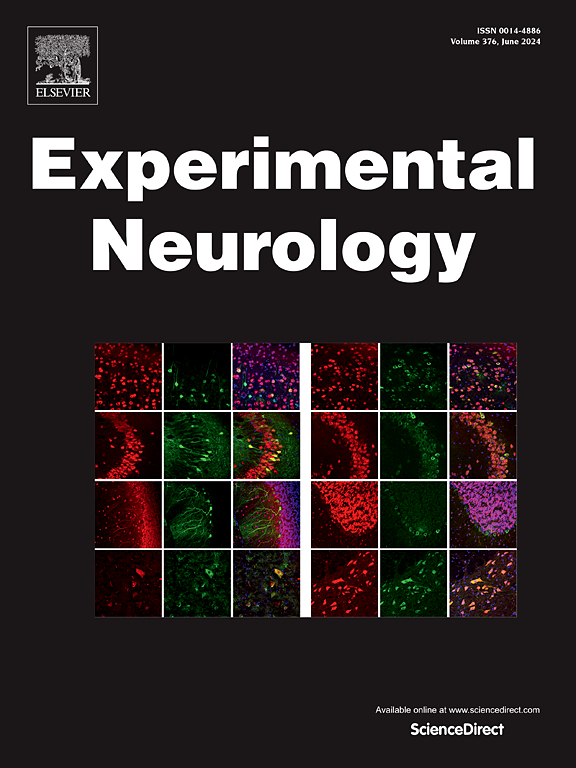雄性大鼠颅顶颞叶撞击致闭合性颅脑损伤急性期行为和病理反应的比较研究
IF 4.6
2区 医学
Q1 NEUROSCIENCES
引用次数: 0
摘要
创伤性脑损伤(TBI)的预后与施加于头部的机械负荷的强度密切相关。然而,相同的机械负荷会导致损伤结果的显著变化,这取决于撞击的位置。为了比较不同撞击部位对TBI急性期行为和病理的影响,我们对雄性大鼠进行了闭合性颅脑顶颞叶撞击的脑损伤实验研究。按照L4(23)正交表建立的实验方案,对撞击器损伤大鼠进行行为和病理结果评估。使用方差分析对冲击位置和强度对TBI的贡献率进行量化。结果表明,冲击强度在TBI中起主导作用,并呈正相关关系,而冲击位置在TBI中的作用不可忽视。行为上,颅顶点撞击导致更严重的昏迷、运动、记忆和焦虑缺陷。在病理学上,颅顶撞击对胼胝体和脑干的弥漫性轴索损伤更为严重。在左侧海马和杏仁核中,颅顶撞击引起的细胞损失比颞叶撞击引起的细胞损失更明显,而右侧海马和杏仁核则相反。值得注意的是,颞叶撞击导致的左侧(非撞击)海马和杏仁核的病理变化与行为结果显示出更强的线性相关性,这表明左侧损伤对行为缺陷具有更强的预测能力。提示撞击位置是影响TBI的重要因素,在研究中应予以考虑。本文章由计算机程序翻译,如有差异,请以英文原文为准。

A comparative study on the acute-phase behavioral and pathological responses of closed head injury induced by cranial vertex and temporal lobe impacts in male rats
The outcomes of traumatic brain injury (TBI) are closely linked to the strength of mechanical loads applied to the head. However, the same mechanical load can lead to significant variations in injury outcomes depending on the location of impact. To compare the acute-phase behavioral and pathological effects of different impact locations on TBI outcomes, we conducted a closed head injury experimental study using male rats subjected to cranial vertex and temporal lobe impacts. The rats were injured by an impactor according to the experimental protocol established using the L4 (23) orthogonal table, and the behavioral and pathological outcomes were assessed. The contribution rates of impact location and strength to TBI were quantified using Analysis of Variance. The results indicated that impact strength played a dominant role in TBI and showed a positive correlation, while the role of impact location in TBI cannot be ignored. Behaviorally, cranial vertex impacts led to more severe coma, motor, memory, and anxiety deficits. Pathologically, cranial vertex impacts caused more severe diffuse axonal injury in the corpus callosum and brainstem. In the left hippocampus and amygdala, cell loss due to cranial vertex impacts was more pronounced than that caused by temporal lobe impacts, whereas the opposite was true on the right side. Notably, the pathological changes observed in the left (non-impact) hippocampus and amygdala due to temporal lobe impacts showed a stronger linear correlation with behavioral outcomes, suggesting that damage to the left side has greater predictive power for behavioral deficits. This suggests that the impact location is an important factor affecting TBI and should be considered in the study.
求助全文
通过发布文献求助,成功后即可免费获取论文全文。
去求助
来源期刊

Experimental Neurology
医学-神经科学
CiteScore
10.10
自引率
3.80%
发文量
258
审稿时长
42 days
期刊介绍:
Experimental Neurology, a Journal of Neuroscience Research, publishes original research in neuroscience with a particular emphasis on novel findings in neural development, regeneration, plasticity and transplantation. The journal has focused on research concerning basic mechanisms underlying neurological disorders.
 求助内容:
求助内容: 应助结果提醒方式:
应助结果提醒方式:


